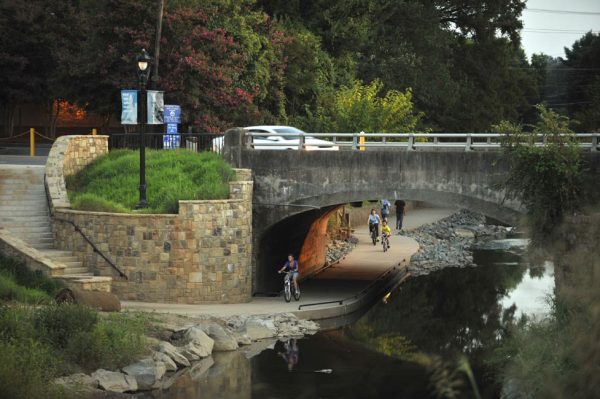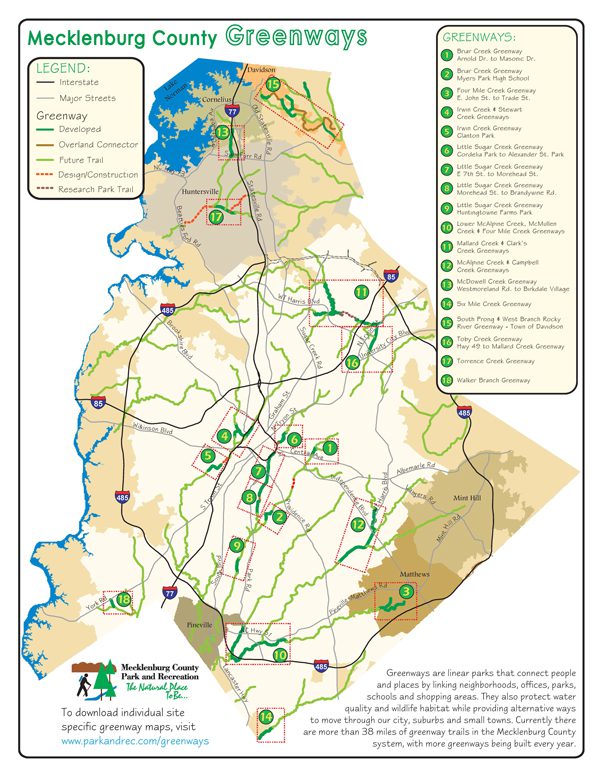Mecklenburg’s 2012 green space assessment: Fair to middling

With three of the four indicators rated “fair,” Mecklenburg County’s land resources have room for improvement, according to the county’s latest State of the Environment Report.
The 2012 report rates four categories of environmental Indicators for land resources: climate change and wildlife, nature preserves, greenways and facility planning. The report did rate climate change and its local implications as “good” but didn’t forecast a trend, other than to note that some species previously not seen here appear to be moving into Mecklenburg due to higher average temperatures.
|
Read more about report This is the third of four State of the Environment report articles. Others examine water quality, air quality and waste. |
It’s generally agreed that natural areas and green space benefit the community in many ways and contribute significantly to residents’ overall quality of life. Mecklenburg County enjoys a beautiful, natural setting within the North Carolina Piedmont region. County residents can experience mountains, rivers, lakes and forests relatively easily by car. Providing access to natural areas is an important function of government on multiple levels, from national to local. Mecklenburg County’s green spaces come in a wide variety of scales, including parks, greenways, nature preserves, land-banked open space and natural heritage sites. The county owns almost 20,000 acres, which includes about 6,900 acres of nature preserve. The report doesn’t give a tally for land preserved by land trusts such as the Catawba Lands Conservancy or the Davidson Lands Conservancy.
Nature preserves and natural areas
Of the almost 20,000 acres of county-owned parklands, 6,980 acres are designated as nature preserve, including Latta Plantation and the Shuffletown Prairie. (The report has a separate category rating for this type of open land, distinct from its “land acquisition” category below.) The economic downturn has hurt the county’s ability to buy and protect open space, and it is not on track to meet its 2008 Master Plan goals in this area – hence, the “fair” rating and downward trend in the report’s indicator for this area.
The 2008 Master Plan was created with high resident and stakeholder input. Given choices, the public respondents said their highest priority was to buy land to preserve open space. The plan called for acquiring 9,747 acres for parks and nature preserves by 2018, not including land needed for future greenways. That would average to about 1,000 acres a year. However, only 808 acres, total, have been acquired over the last three years, just 8 percent of the goal.
The report makes an important observation: Now is the best time to acquire land for open space due to two things: low land prices from the economic downturn, and the ability to act ahead of the county’s eventual build out, expected by 2025. (See “Cheap land? Low prices frustrate cash-strapped preservationists,” Feb. 10, PlanCharlotte.org.) These factors create both a golden opportunity and a significant challenge. In 2011, the N.C. Department of Environment and Natural Resources posted record high levels of visitation to state parks and recreation areas, continuing an upward trend over recent years. According to NCDENR, “a 2008 economic study revealed that travelers spend an average of $23.56 a day to enjoy the state parks.” With reduced incomes and seeking less costly options for vacation, many families are looking for vacations that are closer and not as expensive. Despite strong public support for open space acquisition, the Mecklenburg 2011 Parks and Recreation Annual Report shows only 7 percent of its entire budget of more than $34 million was allocated for nature preserves and natural resources.
The State of the Environment report projects a downward trend for this category. 
Greenways
Greenways and trails have fared better in Mecklenburg than nature preserves, and are rated “fair” and trending upward.
Greenways provide needed corridors and habitat for plants and animals to thrive, as well as transportation routes and recreation for people. For a map of Mecklenburg County greenways, click here or on the image at right.
Citizen surveys done as part of The 2008 Mecklenburg County Greenway Master Plan Update showed that about 68 percent of county residents consider greenways and trails the amenity preferred most for development. A huge majority (93 percent) felt the role of greenways as a connected network of walking, biking and nature trails was important. Similarly, 88 percent described the role of greenways in environmental protection as important or very important.
Federal stimulus funding has helped the county move toward meeting goals set in its 2008 Greenway Plan Update. It called for 42.8 miles of greenway by 2013 with another 61 miles by 2018. But the county’s park and recreation website lists only 37 miles of developed greenways.
A system of greenway trails is meant for transportation as well as for health and wellness. The eventual construction of the Carolina Thread Trail through Mecklenburg County, adopted as part of the master plan update, will link communities and some 2.3 million people along a 15-county regional trail system. The Thread has an average of 100 miles per county planned, but so far only 96 miles of the trail are built.
One Thread Trail section opened in Mecklenburg in May 2011: the Toby Creek Greenway. Paid for with a $1.25 million grant from the American Recovery and Reinvestment Act of 2009 (that is, the federal stimulus act), it stretches 2 miles and allows access to the UNC Charlotte campus by bike or foot from nearby neighborhoods and the University Research Park.
In addition, several portions of the Little Sugar Creek Greenway also opened in 2011. The section nearest uptown Charlotte opened in April 2012, restoring part of the creek hidden for nearly 50 years under parking lots, and stretching the length of three football fields. It took more than 10 years to buy the properties in the floodplain and construct the greenway’s urban section.
With only about 40 greenway miles, Mecklenburg County lags in greenway development compared with other N.C. cities. Greensboro leads the state, with nearly 100 miles of greenways and trails built and plans for more than 400 miles. Raleigh has 77 miles of greenways, covering 3,700 acres. Its extensive network links points in north and south Raleigh to downtown and the N.C. State campuses. Portions of Raleigh’s network parallel I-440 and can be considered a commuter corridor. Similar north-south and east-west routes in Charlotte could make a big impact, especially with automobile-generated air pollution creating the county’s worst environmental problems. (See “Ozone pollution still troubles county.”)
Facility planning and land acquisition
“Facility planning and land acquisition” are rated “fair” and trending upward by the report, and it says that the county is “on target to meet 2008 Comprehensive Master Plan goals of Facility implementation and to meet the needs of the Mecklenburg County community.” The county averages 20.2 acres of parkland per 1,000 residents – a figure well below the national average of 40.2 acres per 1,000 residents.
The need for more neighborhood parks and walk-to facilities is acknowledged, and a quick look at the Mecklenburg County Park & Recreation Countywide Map reveals a need for these types of urban open spaces in such a rapidly developing area.
As with the acquisition of nature preserves, now is an opportune time for the county, as money becomes available, to acquire vacant, undervalued or abandoned properties for redevelopment into more urban-style green spaces, community gardens or plazas. Once land is developed, it is nearly impossible to later convert it back to open space.
Among recent positive developments, the county held groundbreaking ceremonies for Romare Bearden Park in uptown Charlotte on Sept. 2, 2011. The park’s namesake, who was born nearby, was one of the most renowned African-American artists of the 20th century. The new park will cover a full city block at South Church and Third Streets.
Overall, park operations and maintenance accounted for 38 percent of the 2011 departmental budget, the largest share.
Conclusion
The results of citizen surveys as to their needs and desires for recreation are consistent with national trends towards individual outdoor activities that can be ‘done in a day.’ This underscores the importance of providing nearby access to nature through hiking and walking trails, bicycle trails, neighborhood parks, and open space preservation.
In addition to the recreational use of open space, it also provides a needed buffer to the environmental impacts of development. The region has experienced a tremendous increase in impervious surfaces and associated runoff, which can seriously damage streams, lakes and water quality. (Click here for “How’s the water? Maybe not so fine,” Part 2 of this four-part series on the Mecklenburg State of the Environment. To see a series of computer-animated maps showing development in the greater Charlotte region, click here.)
Green spaces help naturally cleanse, reduce and slow polluted runoff before it enters local waterways. The 2012 report recommends implementing the 2008 Park and Recreation Comprehensive Master Plan; continuing the “Greenprint” software program that ranks land for priority acquisition; and looking for partnerships and funding opportunities to help bring the Comprehensive Master Plan to fruition.
Some open spaces can create “airsheds,” or green fingers, that reach into an urban area from its surrounding hinterlands. This helps keep clean air moving through a city, which reduces ground level ozone and temperature inversion. Citizens can show support for the continued development of greenways and for local mechanisms that require development to either set aside land for open space or pay into funds that can be used to acquire large open space parcels.
Melissa Currie